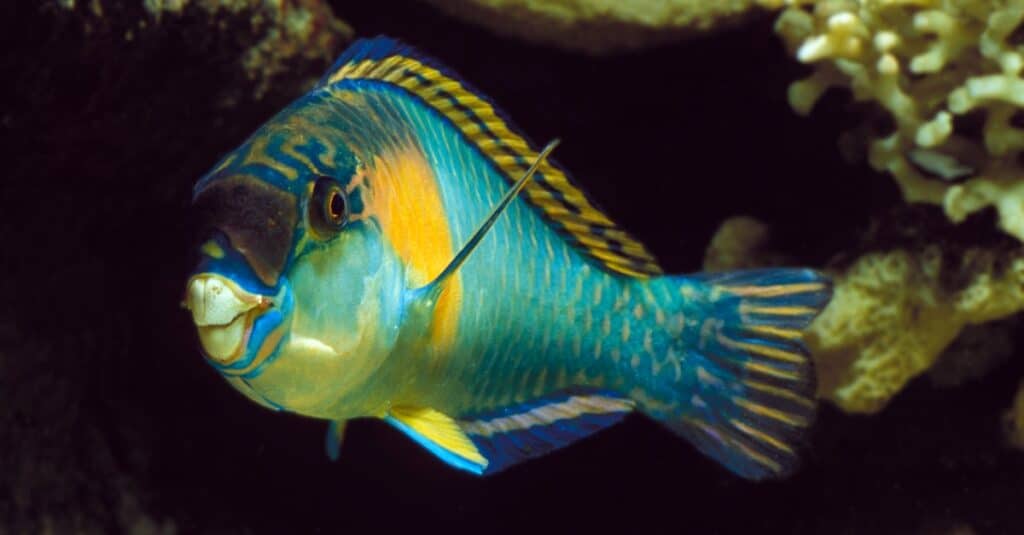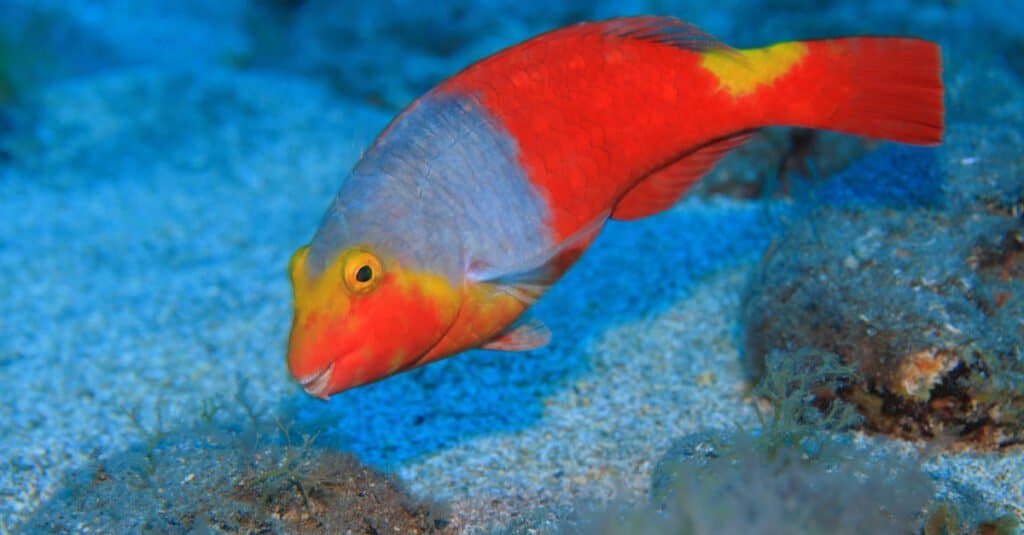Have you ever seen a more colorful and interesting fish before? The parrotfish is one of the most distinct fish in our oceans. There are around 80 identified species of parrotfish in the Scaridae family. The Indo-Pacific area is home to most of these species.
Although they are named after their colorful parrot-like colors and bird-like beaks, no two species of parrotfish appear alike. The parrotfish’s teeth are actually made of fluorapatite, one of the world’s toughest biominerals. The parrotfish’s teeth are therefore tougher than copper, gold, and silver. So what do parrotfish eat with such strong teeth?
If you’re interested in learning more about this fascinating fish, we’ve got you covered. We’ll uncover the parrotfish diet and how they impact the ecosystem.
What Do Parrotfish Eat?

©Richard Whitcombe/Shutterstock.com
Parrotfish are herbivores that eat a diet that consists primarily of epilithic algae.
However, studies done on the parrotfish have found that they do at times feed on other small organisms. These include invertebrates (sessile and benthic species, as well as zooplankton), bacteria, and detritus.
But is that all that parrotfish eat? No, actually!
A few larger species, such as the green humphead parrotfish (Bolbometopon muricatum), consume a lot of live coral (polyps). However, none of them are solely corallivores even though polyps can make up about half of their diet. Most parrotfish, with the exception of the green humphead parrotfish, prefer algae-covered surfaces to live corals, and less than 1% of their bites involve live corals.
Parrotfish also make a great aquarium fish. If you’re interested in keeping a parrotfish as an exotic pet, you will have to feed it twice a day. Even when parrotfish are not hungry, they can consume food. This is why food should be restricted to twice a day.
You may feed parrotfish in an aquarium aqua master high-grade feed because it contains around 40% protein. Protein is especially important for the growth of your pet parrotfish. Shrimp is another fantastic source of protein for them. It meets nearly all of the nutritional needs of parrotfish.
What Predators Eat Parrotfish?

Moray eels and reef sharks are natural predators of parrotfish.
©slowmotiongli/Shutterstock.com
There are only two major natural predators of the parrotfish. These are moray eels and reef sharks. However, there are still other fish that they must watch out for. These include snapper fish and a wide range of larger reef fish.
Recently, lionfish have begun to consume parrotfish in large numbers. Human fishermen will also hunt down these fish with spearheads. This is because they are not often receptive to a baited hook.
Some parrotfish species, such as the queen parrotfish, create a mucus cocoon at night. Before going to sleep, they will release mucus from their mouth, creating the protective cocoon that shields them from potential predators. This mucus envelope may also function as an alert system, allowing the parrotfish to flee when predators such as moray eels disrupt its membrane.
How Does Their Diet Impact the Ecosystem

©aquapix/Shutterstock.com
Now that we know what parrotfish eat, let’s see how that affects the ecosystem. Parrotfish are becoming increasingly essential in tropical reef ecosystems that are suffering from coral cover degradation. Find out how these colorful fish both positively and negatively impact the habitat in which they live.
Keeping Algae Numbers Under Control
The excessive eating of algae by parrotfish has a direct impact on the algal population. Through their big appetites, parrotfish are able to curb just how much algae grows in the ocean. Parrotfish are well-known for their digging and scraping abilities, thanks to their beak-like mouth, which is incredibly powerful. It has a sharp tip that allows them to access hard-to-reach coral reef crevices. This distinguishing characteristic, combined with how much they eat, allowing them to clear algae from the reef, makes the parrotfish vital to the reef environment.
Creators of Sand
If you enjoy walking on a sandy beach, thank a parrotfish. They are actually responsible for converting one ton of coral into sand in a year. As we mentioned above, the fish consumes algae that develop on coral rock. Since their teeth are so strong, as they eat the algae, they also begin to bite into the coral fragments in the process. When the coral is expelled by the parrotfish, it is now crushed and ground up by their digestive system. What comes out is an incredibly fine particle that we know of as sand. A single parrotfish may create up to 199 lb of sand every year, according to scientific estimates.
So the next time you’re walking on the beach, you may be walking on parrotfish waste.
They Negatively Affect Coral Colonies
Parrotfish have a direct impact on the size and concentration of coral reef colonies. Because of how frequently they graze for food, this causes variations in the population composition and size of coral colonies. By inflicting repetitive, overlapping bites that cause severe damage and decimate large sections of coral tissue, focused biting can severely harm the reef. The act of spot biting, however, is advantageous to the reef environment. This is because bites are generally distributed evenly throughout the entire skeleton of the reef, clearing algae while avoiding repetitive damage to the coral tissue.
Creating Changes in the Reef’s Structure
As mentioned just above, parrotfish have the ability to eat and change the structure of coral reefs by removing algae turfs and coral tissue. When they are grazing, it is often concentrated on the reef’s crust. Scraping is typically done around the short algal turfs, leaving scarring on the reef. Because parrotfish will both scrape and graze, they directly impact the shape of the reef as well as the interaction between reef ecosystems.
Parrotfish will continue to eat in the same areas where there are the most nutrients for them to consume. The removal of algae in the same region on a regular basis generates scarring on the reef. This eventually negatively affects the structural form by preventing future development in the scarred area.
The photo featured at the top of this post is © slowmotiongli/Shutterstock.com
Thank you for reading! Have some feedback for us? Contact the AZ Animals editorial team.






